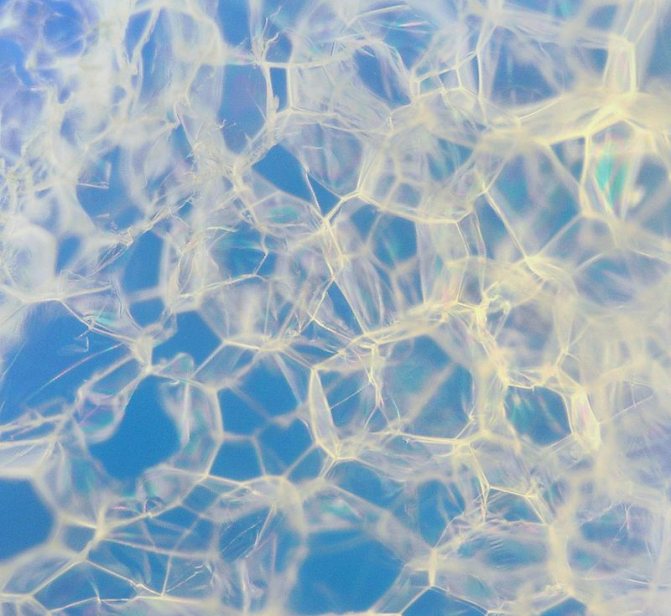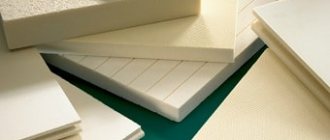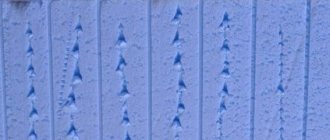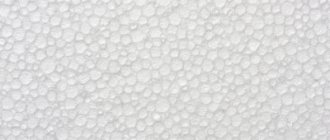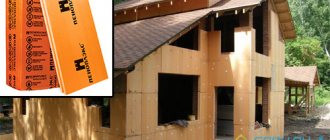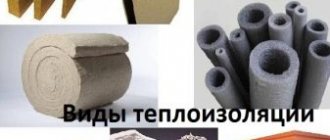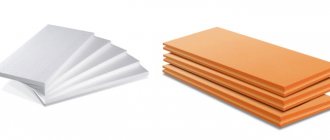Expanded polystyrene is a gas-filled material obtained from polystyrene and styrene copolymers. The gas-filled styrene granules are dissolved in the polymer mass, then the mass is heated with steam, as a result of which the initial granules multiply in volume. The granules occupy a block shape and are sintered together. This technology is used to produce expanded polystyrene.
Natural gas is used for standard styrofoam. For fire-resistant - carbon dioxide. Expanded polystyrene is an inexpensive building material that does not require special knowledge and special equipment to work with it. The material is used mainly as thermal insulation and less often as decorative elements.
- 2 Scope of application of expanded polystyrene
- 3 Advantages and disadvantages of expanded polystyrene
- 4 Technology of insulation with expanded polystyrene
4.1 Thermal insulation of a concrete floor using expanded polystyrene granules
- 4.2 Insulation of floors with expanded polystyrene sheets under a concrete screed
- 4.3 Insulation of floors on logs
How to choose polystyrene foam
So, you have decided to insulate your house with expanded polystyrene. Let's take a look at how to choose the right quality material. When buying insulation, pay attention to the following criteria:
- Appearance... The material should be free of peeling granules, uniform white color, no damage or debris.
- Smell... The material must not have any chemical or other foreign smell.
- Structure... Granules should be well sintered, approximately the same size, the fracture line at breakage should pass both between the granules and directly inside them.
- Packaging... Buying material in unique labeled packaging with information about the manufacturer, regulatory document, its brand and recommendations for use, you can be sure that you are purchasing high-quality expanded polystyrene.
- Information on the characteristic of expanded polystyrene... The packaging must indicate the thermal and physical and mechanical characteristics, as well as the dimensions of the sheet.
- Place of sale... Material you need to buy at legal points of sale, in the presence of which there is a covered warehouse.
You can read about the main characteristics of extruded polystyrene here:
Facade expanded polystyrene psb with 25f - characteristics
Main parameters:
- density - 15 - 25 kg / m3;
- compressive strength - at least 0.1 MPa;
- bending strength - 0.18 MPa;
- thermal conductivity - no more than 0.039 W / m2 * С;
- water absorption - maximum 2% of the total volume (during the day);
- vapor permeability - 0.05 mg / (m * h * Pa);
- operating temperatures - from -60 to +80 degrees Celsius;
- the operational period is from 20 to 50 years.
In industry, this 25F facade foam is produced in the form of slabs, the thickness of which varies from 20 to 500 mm. The dimensions of the sheets are as follows: 1000 by 1000 mm, 1000 by 1200 mm and 1000 by 2000 mm. If necessary, smaller slabs are cut.
Scope of application of expanded polystyrene
Depending on the density of the material, expanded polystyrene is used in the following areas:
- As unloaded thermal insulation slabs with a density of up to 15.0 kg / m3 used in enclosing structures such as: floors, internal partitions, pitched roofs, attic floors, insulation of balconies, containers, etc.
- For loadable thermal insulation slabs with a density of 15.1 to 25.0 kg / m3 used in the production of sandwich panels and in the insulation of walls, floors, rabbits, three-layer walls with a protective and decorative layer of brick.
- Any facade brands of slabs with a density of 16 to 20 kg / cubic meter. used for thermal insulation of vertical enclosing structures various facade thermal insulation systems with external plaster layers.
- Plates with a density of 25.1 to 25.0 kg / m3 used in structures with significant loads - Self-leveling floors in civil and industrial construction, insulation of foundations, walls in basements. And also in the manufacture of packaging products.
- Plates with a density of 35.1 to 50.0 kg / m3 are used as thermal insulation for surfaces that are particularly loaded during operation. - basement floors, zero cycles of buildings, garages and parking lots, in the construction of floors and roofs used for automobile and pedestrian loads, etc.
The consumer must know all the properties of the thermal insulation material in order to make the best decision for himself. Consider the pros and cons of expanded polystyrene.
The fact that polyurethane foam or expanded polystyrene is better can be learned from this material:
Where is expanded polystyrene used
Basically, extruded polystyrene foam is used to insulate such building elements:
- ceilings;
- floors;
- foundation;
- walls;
- doorways;
- window openings.
For example, when fastening this material to the floor, it does not reduce the height of the room and is suitable for floors with different heating systems, as well as for those floor coverings that are located under basements or run on the ground.
The advantages of installing this material on the floor are as follows:
- high compressive strength;
- maximum application period;
- minimum deformation;
- minimum thermal conductivity.
The floors should be insulated with expanded polystyrene in rooms that are operated at low temperatures, where there is a need to withstand heavy mechanical loads or high levels of humidity.
Expanded polystyrene boards can be attached directly to concrete, for this you just need to prevent the insulation boards from intersecting with concrete joints.
Advantages and disadvantages of expanded polystyrene
TO positive the qualities of the material include the following points:
- Ease of use... Styrofoam plates are easily processed with a household knife or fine-toothed hacksaw. Easily fastened with mounting accessories, glued with glue or cement mortar.
- Light weight... Due to their low weight, the slabs can be lifted to a height without additional mechanisms.
- Environmentally friendly product. Expanded polystyrene is not poisonous, does not emit dust during processing, is odorless and does not cause skin irritation.
- Resistance to biological and chemical influences... Due to the fact that foam is a synthetic product, animals and microorganisms do not use it for food. It is also not a habitat for bacteria and fungi.
The advantages of the material include such qualities as sound insulation, moisture resistance, low price and durability of the material (more than 50 years).
Negative the qualities of this insulation are much less:
- Deformation... Low heat resistance allows the development of thermal deformation at a temperature of + 80-90 degrees.
- Flammability... Gas-filled expanded polystyrene granules are capable of igniting at very high temperatures.
- The need for protection from mechanical damage
Having familiarized yourself with the basic properties of the material and opting for polystyrene foam, you can use the following options for floor insulation. Warm floors are an integral part of an energy-efficient home. Floor insulation with expanded polystyrene under the screed will help reduce heat loss and will make the temperature in the room comfortable and cozy.
Insulation with expanded polystyrene is an affordable and simple way of thermal insulation.
Extruded polystyrene foam
- water absorption by volume does not exceed 0.2%, which indicates almost complete waterproofness;
- thermal conductivity at (25 ± 5) ⁰C, no more than 0.032 W / m • K indicates the minimum values. So, for example, a three centimeter thick corresponds to a 56 centimeter red brick laying;
- high resistance to deformation, suitable for blind areas, for the foundation;
- resistance to inorganic chemical compounds and solvents;
- able to withstand extreme temperatures from minus 50⁰С to plus 75⁰С;
- long service life, the manufacturer assures that the service life has been exceeded 50 years;
- environmental friendliness of the material;
- light weight;
- small thicknesses.
A few words about the environmental component. Note that, apart from being used for construction purposes, extruded polystyrene foam can often be found in the nearest supermarket in the form of light disposable plates and other cheap dishes. You can even find this material in children's toys. As we know, in such products, ecology is or at least should be at the highest level.
Insulation technology with expanded polystyrene
Insulation of a concrete floor using expanded polystyrene granules
Adding granules to the concrete solution allows the concrete floor to acquire thermal insulation properties. To do this, mix the concrete solution. Add dry cement to a small amount of water and stir with a drill with a special nozzle until the consistency of sour cream. Without stopping to interfere, polystyrene granules are added to the solution. This can be the ratio of concrete to granules as 1: 3 and 1: 6. Than the more filler, the warmer the floor... Depending on what hard floor covering the concrete-expanded polystyrene screed will then be covered, the ratio is determined. The more granules, the lower the strength. Also, the screed with granules has a soundproofing quality.
Insulation of floors with expanded polystyrene sheets under a concrete screed
To begin with, the soil is compacted, crushed stone is poured and a layer of sand and a film are covered on top. Then the sheets of material are laid tightly around the entire perimeter of the floor. The joints are filled with polyurethane foam or glued. Lay another layer of film. To protect sheets from mechanical stressto which the floors are exposed must be laid on the sheets durable mounting mesh... Fill the surface with a 40-60 mm thick screed mortar. When the solution hardens, the floor covering is laid.
Insulation of floors on logs
If the floor is made using a log, then it becomes much easier to insulate the floors. To begin with, wooden floor elements are processed antifungal drugs and moisture protection agents. Then, boards or sheets of chipboard are attached to the self-tapping screws from the lower side of the lags, and sheets of material cut to the size of the opening are laid on them. From above, the covering is covered with foil and floor covering.
An article dedicated to floor insulation with penoizol is here:
- I plaster foam plastic, expanded polystyrene on the foundation (plinth) with my own hands Second Channel - I LIVE IN THE VILLAGE ... I PLASTER POLYSTYRENE FOAM ON THE FOUNDATION WITH OWN HANDS 3,708 views ⌚9 months ago
- Garny peregryazі friends. Preparing the wall for tiles with expanded polystyrene. Steam room floor tiles 1,341 views ⌚10 months ago
- Wedge shaped acoustic diffuser. ACOUSTIC POLYSTYRENE PANEL ECHOTON STYROFOAM AURA 138 views ⌚10 months ago
- 8-903-743-27-96 8-903-724-77-28 n-dom.ru ceresit.msk.ru terraco.pro How Ceresit CT84 glue foam is applied to the sheet ... How to apply foam glue to the expanded polystyrene sheet, plaster facade on a frame house 2 ⌚10 months ago
- It is not the first year that SIBUR has been producing AlfaporTM expanded polystyrene in Perm. It has found wide application ... Extruded polystyrene foam CARBON ECO VS CARBON ECO FAS_with_titer 159 ⌚10 months ago
- 8-903-743-27-96 8-903-724-77-28 n-dom.ru ceresit.msk.ru terraco.pro How to insulate the basement of a house with extruded ... "Green" expanded polystyrene: a new word in sustainable construction 24 264 views ⌚10 months ago
- Thermal insulation of a balcony is a relatively simple measure that can increase the level of comfort in ... How to insulate the basement of a house with extruded polystyrene foam, glue it on Ceresit CT84 glue-foam on bitumen 4 205 views ⌚10 months ago
- Preparing the site for laying, and trimming polystyrene foam.Thermal insulation of a balcony with TECHNONICOL extruded polystyrene foam with finishing with plastering compounds 3 ⌚10 months ago
- We disassemble the expanded polystyrene under the Intex Frame Pool after 3 years. What happened to the sand pillow? Me ... Mats contour penoplex expanded polystyrene 3 views ⌚10 months ago
- Reinforcement of a floating screed on expanded polystyrene using a Shtrek mesh laid on 6mm beacons as ... Warm pool, preparation of a warm base for the pool, made of extruded polystyrene foam 423 views ⌚10 months ago
- Line for the production of extruded polystyrene foam-PENOPLEX PRODUCTION e-mail:… We disassemble the expanded polystyrene under the Intex Frame Pool after 3 years. What happened to the sand pillow? 5 ⌚11 months ago
- 8-903-743-27-96 8-903-724-77-28 n-dom.ru ceresit.msk.ru terraco.pro Replacing Penoplex with Expanded polystyrene when insulating ... The best REINFORCEMENT of a screed on expanded polystyrene 1 ⌚11 months ago
- This video demonstrates how you can reduce your work time by choosing an XPS façade. Extruded polystyrene foam production line-PENOPLEX PRODUCTION ⌚11 months ago
- Don't be fooled !!! Part No. 1 Inspection of polystyrene and Penoplex (TECHNONICOL CARBON) with a thermal imager. Replacing Penoplex with expanded polystyrene when insulating reinforced concrete lintels of an aerated concrete house 2 ⌚11 months ago
- Hives from PPU and PPP. What does a real master choose? Extruded polystyrene foam CARBON ECO VS CARBON ECO FAS 323 views ⌚1 year ago
- Dimensions 600 * 600 * 130 mm Echoton Pixels StyroFoam (2 pcs.) is a set of acoustic diffusers (diffusers), ... Don't be fooled !!! Part No. 1 Inspection of polystyrene and Penoplex (TECHNONICOL CARBON) with a thermal imager. 89,325 views ⌚1 year ago
- Subscribe https://www.youtube.com/channel/UCP0ANXE—yOAWiV7bVMLx2w?... # UlyaPPS ... V. G. Kashkovsky "Beehives made of polyurethane foam and expanded polystyrene (PPU and PPS)" 04/24/2019. 13 ⌚1 year ago
- What the owner of the house faced after insulating the attic with foam, what are the reasons, details and what to do. … ACOUSTIC POLYSTYRENE PANEL ECHOTON PIXELS STYROFOAM 656 views ⌚1 year ago
- Styrofoam hives, EPS, (XPS) Part three. 363 views ⌚1 year ago
- How to insulate an attic with POLYSTYRENE FOAM. 36,361 views ⌚1 year ago
Tags:
By dates: 05/27/2020 - 05/28/2020 - 05/29/2020
Commented video:
Template Media Triangle Slideshow sony vegas 12 13 14
⇒ "I look, I don't quite understand where it was filmed, there is a very similar carousel in the Okhotny Ryad area." Watch in full ... Added - 05/28/2020
‘Making the Right Decisions’ everything you need to know about HIV
⇒ "Class" View in full ... Added - 05/28/2020
In Dagestan, a driver shocked by the disappearance of a car caught on video
⇒ “This is what it can bring if you leave the car not on the handbrake. Then you can believe in ghosts who steal a car in broad daylight. " Watch in full ... Added - 05/28/2020
[10 o'clock] ZELENSKY - LEAVE HERE THE ROBBER
⇒ "cool" View in full ... Added - 05/28/2020
Keystrokes Mod v5 Download | 1.7.10 - 1.8.9
⇒ "lol" Watch in full ... Added - 05/28/2020
Lessons of Aunt Owl - ABC Baby. Letter U
⇒ "great" Watch in full ... Added - 05/28/2020
How to avoid common mistakes
To work with expanded polystyrene to be of high quality, avoid the following mistakes.
- Special attention to the base / plinth rail... If horizontal cracks suddenly appear on the plaster, then the plinth rail was not fixed correctly. To correct the errors, you need to remove 10 cm of plaster from the bottom edge and cut off part of the insulation that covers the rail. Fasten the rail and cover it with a net to the bottom edge. Then the new mesh is overlapped by 10 cm with the old one and covered with fresh plaster.
- Contact of polystyrene foam with the ground... When expanded polystyrene comes into contact with the ground, the material quickly gets wet and becomes unusable. Here, a plinth strip is needed, which performs a protective function. To correct the error, you need to cut off the bottom edge of the insulation and replace it with extruded polystyrene foam.
- When using three-layer enclosing structures in which the outer and inner walls are made of small blocks or bricks, polystyrene foam should not be used. In this case, mineral wool in slabs is more suitable. Also do not use expanded polystyrene as insulation for wooden houses... The material traps the release of water vapor to the outside, thereby causing wood to rot.
- Weather conditions are very important in the work on insulation. Work should be carried out in dry weather at temperatures from + 5 to + 25 degrees.
- Failure to comply with the thickness of the insulation... If too thin a slab layer is applied to walls made of concrete hollow blocks or large slabs, the buildings will still be cold.
- The emergence of thermal bridges... When used in fixing the plates with dowels of an unsuitable quality (in the future, the supporting discs disappear), thermal bridges arise, which contribute to intense heat leakage.
Whatever insulation you would use, we can say with confidence that after installing thermal insulation, the house will become warmer, and the atmosphere in it will be pleasant for residents.

